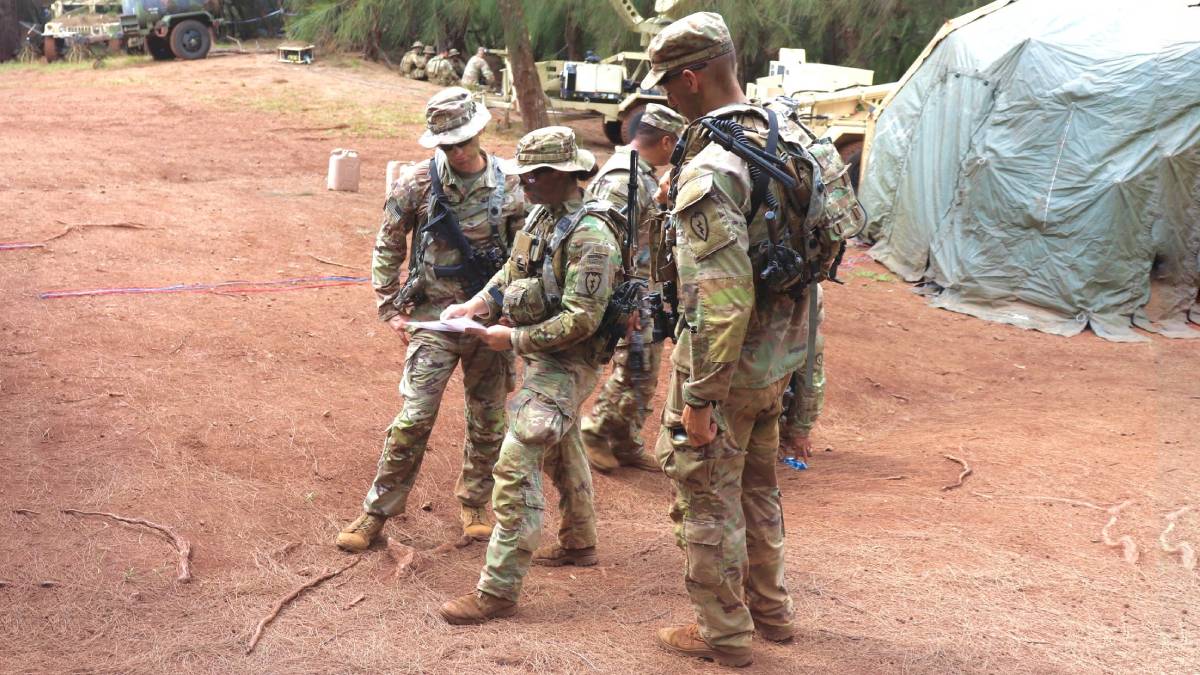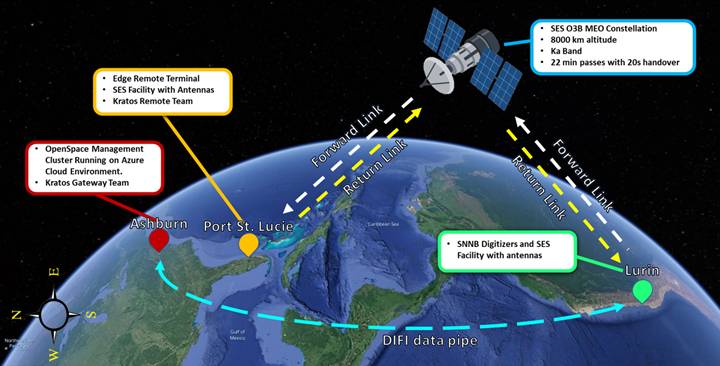 Soldiers with the 3rd Infantry Brigade Combat Team, 25th Infantry Division prepare for their first assault mission on August 25, 2021, during the unit’s Bronco Rumble exercise at the Kahuka Training Area, Hawaii. (Source: Kathryn Bailey/U.S. Army PEO C3T)
Soldiers with the 3rd Infantry Brigade Combat Team, 25th Infantry Division prepare for their first assault mission on August 25, 2021, during the unit’s Bronco Rumble exercise at the Kahuka Training Area, Hawaii. (Source: Kathryn Bailey/U.S. Army PEO C3T)
ALEXANDRIA, Va. — It’s a digital world. Communication, observation, navigation, even warfare occur at the level of 1s and 0s within a virtualized or software-defined environment.
Military leaders are seeking to secure this new world by leveraging the flexibility, scalability and resilience inherent to digital transformation.
Most recently, offices within the U.S. Army requested a series of demonstrations to show the viability of virtual ground infrastructure for military satellite communication (MILSATCOM). The demonstrations occurred across multiple orbits (LEO and MEO) using multiple satellite operators (Telesat and SES) with secure links established through software-defined ground platforms hosted both in the cloud and on generic servers.
The Case for a Small Footprint
Unlike traditional satellite communications architectures, a virtual satcom network is not limited to a single physical form factor. Software-defined architectures unlock various configurations with a much smaller physical footprint at the gateway than analog systems. In the context of MILSATCOM, this can mean the difference between transporting hundreds or thousands of pounds of purpose-built equipment in theater or deploying a small server rack, remote terminal and an antenna.
In conflict, satellite connectivity is often the only tether a soldier has to the outside world. Local infrastructure is either nonexistent or not secure, so MILSATCOM is deployed to ensure critical communications. Virtualizing components of the MILSATCOM ground segment (e.g. virtual modems, virtual channelizers, virtual combiners, virtual switches, etc.) and running those in a software or cloud environment, minimizes the footprint of satellite communications in the field. Combined with on-orbit advances, digital ground can also enable a level of scalability and speed that represents a potential revolution in military communications.
Consider the use of UAVs, which have proven invaluable in recent conflicts, including Afghanistan, Ukraine and Israel. “How do you take that tactical video and give it back to a strategic UAV operator or operation center with real-time intelligence that’s valid and of good enough quality that they can make decisions?” asked Philip Harlow, President of Telesat Government Solutions. “That’s where we’re moving.”
Linking to Telesat in LEO
In a demonstration for the U.S. Army Program Executive Office for Command, Control, Communications Tactical (PEO C3T), Telesat, Cobham and Kratos tested the basic functionality of a virtual satcom system by establishing a link to an overhead satellite and transmitting video. Telesat provided the terminal and time on LEO 3, a prototype of the upcoming Pathfinder satellites that will comprise the Telesat Lightspeed constellation. A Cobham tracker antenna was outfitted with a Kratos digitizer and used for the handoff. The ground segment was essentially a half-rack server running the Kratos OpenSpace virtual ground system which orchestrated a series of Kubernetes-based containerized network functions (CNF).
“All of what we built was based on open, available carrier, waveform and data processing standards. So, none of this is proprietary,” said Aaron Fletchersmith, Lead Systems Engineer at Kratos. “That means all the inputs and the output from this system could potentially be interchangeable with existing MILSATCOM equipment that’s already on site.”
 This image shows the ground segment used in the virtual satcom demonstration presented to the U.S. Army PEO C3T by Cobham, Kratos and Telesat. (Source: Aaron Fletchersmith/Kratos)
This image shows the ground segment used in the virtual satcom demonstration presented to the U.S. Army PEO C3T by Cobham, Kratos and Telesat. (Source: Aaron Fletchersmith/Kratos)
At a time of budgetary constraints, the U.S. Department of Defense has emphasized the importance of acquiring new technologies and capabilities without investing to replace existing, functional equipment.
Similarly, all military service branches have put a premium on multi-orbit capabilities, where a single ground station can connect with spacecraft at different altitudes run by different operators. This was also demonstrated in the virtual satcom test. Virtual or software-defined modems hosted locally on a server (in the case of the LEO demo) or in the cloud allow operators to not only switch from one waveform to another but also to bring that waveform to multiple orbits.
“From our perspective, it was very straightforward technically,” Harlow said of Telesat providing the forward and return links for the demo. “But conceptually it validated the entire concept of the multi-orbit capability. From that perspective, it was pretty significant.”
SES in MEO and the Cloud
The demonstration of virtual satcom in MEO utilized the SES O3b constellation and was part of contract work with the U.S. Army’s Network Cross-Functional Team (N-CFT). SES managed seamless handoffs between its MEO satellites as they became visible on the horizon. The virtual components used to establish the link were similar to the LEO test with one critical difference: they were instantiated in the cloud.
The test took place across two continents. The antenna and gateway were located in Lima, Peru; the user terminal was in Port St. Lucie, Fla.; and the CNFs were running on a Microsoft Azure cloud connection hosted at a Northern Virginia data center. Engineers joked that the system had essentially “no form factor,” since so much of the signal processing happened in the cloud.
“We provided what I would say is an initial glimpse at the art of the possible,” said SES Space and Defense Vice President of Product Management Michael Geist.
Specifically, the demonstration showed the possibility of quickly spinning up customizable virtual waveforms in the cloud, using an open standard, digital IF stream (DIFI) to transport those to a gateway, then transmitting those waveforms over high-speed, low-latency satellite links to the remote user terminal.
“It was a step in the right direction in terms of a future that involves more flexible and scalable networks for our customers with faster provisioning times and greater connectivity security,” Geist said.
 This graphic depicts the cloud-based virtual satcom demonstration in MEO with Kratos and SES for the U.S. Army N-CFT. (Source: Kratos)
This graphic depicts the cloud-based virtual satcom demonstration in MEO with Kratos and SES for the U.S. Army N-CFT. (Source: Kratos)
Virtual satcom has also been demonstrated in GEO. Intelsat, which is part of a planned merger with SES, has incorporated virtual network functions into its SmartEdge terminal, with an emphasis on the benefits of software-defined networking for multi-orbit connectivity.
All Gateways Great and Small
One of the most interesting aspects of the Army demos was the variation in the gateways, according to Fletchersmith, who participated in both the LEO and GEO tests. “Since it was all software-defined you could deploy the gateway as small or as large as you wanted to, depending on where you were. And each deployment differed.”
That was possible because the core of the system was software-defined. It used and reused containerized network functions that could be instantiated anywhere, anytime, in whatever quantity was supported by available power and processing. In practice, this can create significant advantages when establishing communications at a forward operating base or expanding capacity at a main operating base with minimal equipment.
It also helps users take advantage of various DoD and commercial satellite constellations across multiple orbits. “It sort of validates the idea of any waveform, any orbit,” explained Harlow. “On either side of that equation, it enables those end users to be able to access whatever assets are available, most reliable or have the characteristics that are necessary for the mission.”
‘Catch Me if You Can’: Benefits of Disaggregation
Software-defined MILSATCOM solutions, especially cloud-based, also promise a level of resilience that cannot be achieved with hardware-centric infrastructure.
Once a virtual ground segment parent site has been established, the network operator not only can receive any waveform from any altitude, but they can also access multiple downlink sites, Harlow noted. “Now you’ve got a huge diversity of ground segments,” he explained, so a denial of service or kinetic attack on a single ground site has a lesser impact.
Similarly, a decentralized, software-defined ground network minimizes the impact of an attack or disruption at a military headquarters. “You do that through disaggregation,” Harlow said. “So, if you lose a site or more than one site, you still have a robust infrastructure that can carry the signals where they need to get to.”
This level of resilience is paramount, especially as the Department of Defense adopts commercial capabilities through programs like the Commercial Augmented Space Reserve (CASR) and adversaries declare commercial satellites legitimate targets in conflict. An increasingly contested electromagnetic warfare environment is yet another call to action for multi-orbit, multi-mission, multi-path satcom networks.
“Any time we can utilize a waveform in the cloud and then distribute that via IF streaming to a primary gateway, backup gateway and tertiary gateway to have assured connectivity, then we’re providing that disaggregation and resilience to our customers from a networking perspective,” said Geist.
When the network is largely software-defined, switching gateways and redirecting network traffic becomes much simpler. “It becomes a ‘catch me if you can’ scenario,” Geist added.
Making the Digital Transition
Virtualization in satcom networks has been a long time in the making, going back to the earliest models of software-defined modems or the flexible modem interface. Recent demonstrations and proposals across the DoD suggest it’s a technology whose time has come. However, like any large enterprise, the military is reluctant to suddenly swap out vast amounts of functional hardware and user equipment.
“One of the big things that all armed forces suffer with is this transition plan,” Fletchersmith said. The process of getting a single piece of technology certified, plus cybersecurity requirements, can take years. “Often, by the time it’s implemented, that piece of equipment has gone from prototype to end of life.”
That’s not necessary if DoD can continue using equipment that’s already in service, such as legacy teleports, user terminals and standard servers for hosting VNFs or CNFs. From a functional standpoint, half of the system could be software-defined and half could be legacy military equipment, Fletchersmith said.
Geist reiterated that virtualization does not mean replacing the entire architecture. “Depending on your application, depending upon your use case … and what you’re trying to accomplish, you may only need virtualization at the gateway side of things or the user terminal side. You may desire virtualization on both sides,” explained Geist. What’s critical is that the same waveforms can interoperate in each instance, whether it’s a purpose-built environment, a software-defined environment or a virtualized environment, he continued.
Currently, that level of interoperability is limited by the willingness of modem vendors to instantiate their waveforms in each environment. Vendor lock remains a concern for the military—and non-defense organizations—and many hope digitalization and virtualization technologies can offer a solution.
“When you move things into that digital and virtual environment, new intellectual property will be created, new business models will be created for accessing future customers and delivering new kinds of services,” Geist said. “It’s that future we’re really excited about, as should be the case for any innovative company.”
Explore More:
Podcast: Playing Poker, Changing Mindsets and Space Superiority
Tracking Interference: The Ukrainian Battlefield Reaches into Space
Virtual Ground Demo at SatelliteAsia Provisions Active Satcom Link Over Cloud
Is Cloud Native Make or Break for Satellite 5G?
Pioneering Resilience: PdM WESS and the Digital IF Revolution
